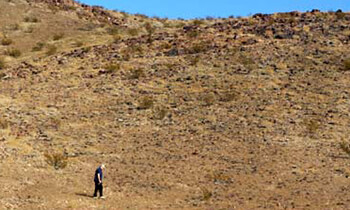Sand Dunes
How Sand Dunes Are Formed
Kelso Dunes: The Mystery of the Missing Sand
There is an extraordinary dune system in the Mojave National Preserve that has an unexpectedly mysterious history. Huge amounts of sand were needed to build Kelso Dune's delicate wind-created sculptures, but geologists studying the Preserve discovered that no new sand is moving in to replenish the dunes. Where did the sand originally come from? What made it stop accumulating? The Kelso Dune sands remained a mystery until very recently.

Back to the source
By studying the mineral composition and shapes of sand grains that make up Kelso Dunes, we know that most of the sand has traveled all the way from the Mojave River sink east of Afton Canyon. Wind blowing from the northwest gradually carried the sand southeastward. In the path of the prevailing winds lie the Providence Mountains and the pink pinnacles of the Granite Mountains. The rocky crags and sloping fans of the two ranges block the moving sand. Sand piles up at the base of the mountains and along their flanks, forming dunes and sand sheets.
Stack 'em up
Where the sand piles up researchers found that the dunes are actually made up of several sets of dunes, stacked one on top of another. Each set formed in response to some past climate change! The Kelso Dunes depend upon times when the sand grain (sediment) supply is enhanced. This happens whenever the climate is dry enough to expose the raw material of dunes, sand, to the wind. In fact, most of the eastern part of the Kelso Dunes formed when water-filled Soda Lake and Silver Lake dried up, exposing the lake bottom sediment. The entire dune system was stacked up in five major pulses over the past 25,000 years.

Eureka Dunes Looking West
By G. Thomas at English Wikipedia - Transferred from en.wikipedia to Commons., Public Domain, https://commons.wikimedia.org/w/index.php?curid=32916688
Some make sound
Acoustical "booming" dunes are rather widespread on earth, including the Sahara Desert, Middle East, South Africa, Chile, Baja California and the Hawaiian Islands. California has at least two documented areas with booming dunes, the massive Kelso Dunes of San Bernardino County and the scenic Eureka Dunes of Inyo County.

Kelso Dunes 2012
By "Mike" Michael L. Baird, CC BY 2.0, https://commons.wikimedia.org/w/index.php?curid=19030269
Plants and critters move in
Over the past few thousand years plants have progressively covered and stabilized areas once covered by drifting sand. As you explore the dunes look for tracks left behind by the many creatures that call these dunes home.
Sand on the move
Once bedrock is broken down into blocks, water begins to transport them downstream. Eventually large blocks may be jostled around enough to be broken into sand-sized grains. Sand and other sediment usually ends up deposited along the sides of streams, in lakes, or in the ocean.

You probably already know that sand dunes are sculpted by wind. As long as streams flow and lakes stay wet, the sediment in them is protected. When lakes or stream beds dry out the sediment is exposed to the wind and the particles are ready to move!
All it takes is a bit of breeze (16 kilometers/hour or 10 miles/hour) to put fine sand in motion. The finest grains may be suspended in the air and carried along (suspension). Heavier grains tend to bounce along as they are lifted into the air, fall back to the ground, then bounce back up again (saltation). The heaviest grains the wind can move are usually nudged along by impact from bouncing, saltating grains (impact creep).
Pile up!
Once sand begins to pile up, ripples and dunes can form. Wind continues to move sand up to the top of the pile until the pile is so steep that it collapses under its own weight. The collapsing sand comes to rest when it reaches just the right steepness to keep the dune stable. This angle, usually about 30-34°, is called the angle of repose. Every pile of loose particles has a unique angle of repose, depending upon the properties of the material it’s made of.
 The repeating cycle of sand inching up the windward side to the dune crest, then slipping down the dune’s slip face allows the dune to inch forward, migrating in the direction the wind blows. As you might guess, all of this climbing then slipping leaves its mark on the internal structure of the dune.
The repeating cycle of sand inching up the windward side to the dune crest, then slipping down the dune’s slip face allows the dune to inch forward, migrating in the direction the wind blows. As you might guess, all of this climbing then slipping leaves its mark on the internal structure of the dune.
Source - US Geological Survey Western Earth Surface Processes Team and the National Park Service.
Where do rocks come from?
Rocks are divided into three basic types, igneous, sedimentary and metamorphic, depending upon how they were formed. Plate tectonics provides an explanation for how rocks are recycled from igneous to sedimentary to metamorphic and back to igneous again.
Igneous
Sedimentary
Metamorphic
More on Sand Dunes
Life on the Dunes
Phenomena of the Wind!
Share this page on Facebook:
The Desert Environment
The North American Deserts
Desert Geological Terms







